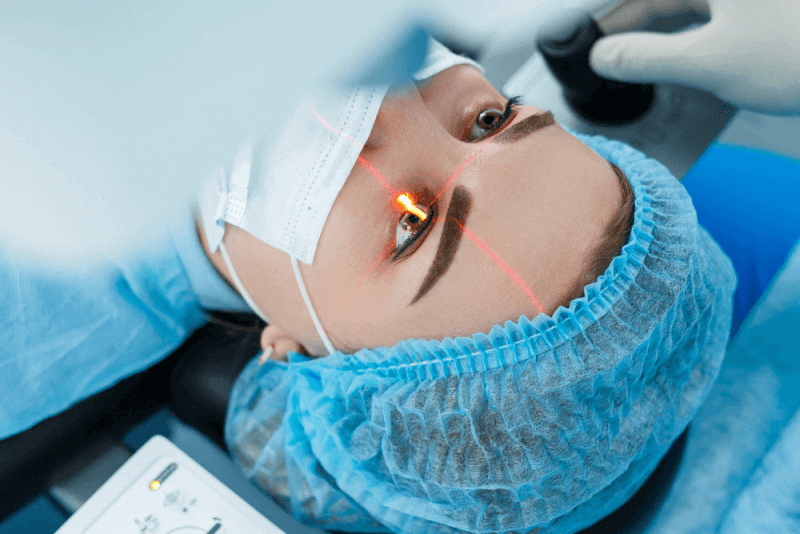30-Second Summary
- Vitrectomy surgery refers to the procedure of removing the vitreous substance located in the back of the eye and surgically addressing problems in the retina.
- Retinal surgery is primarily used for retinal detachment, diabetic retinopathy, macular hole, and vitreous hemorrhages.
- Vitrectomy has a high success rate and is relatively low risk in terms of complications.
- Patients should minimize their activities on the day following surgery.
What is Vitreoretinal Surgery (Retinal Surgery)?
Vitreoretinal surgery is the surgical procedure in which the gel-like vitreous substance in the back of the eye is removed to allow access to and treatment of retinal issues.
The vitreous gel is removed to facilitate access to the retina, allowing treatment of various retinal disorders. After the procedure, the vitreous is replaced with a gas bubble, saline solution, or silicone oil to keep the retina in place.
In Which Conditions is Vitreoretinal Surgery Performed?
Retinal surgery is commonly used for retinal detachment, diabetic retinopathy, macular hole, and vitreous hemorrhages. Additionally, it may be performed in the following cases:
- Age-related macular degeneration
- Macular hole
- Retinal surgery
- Vitreous detachment
- Macular edema and membrane
- Retinal detachment
- Intraocular hemorrhages
- Intraocular foreign body
- Intraocular inflammation
How is Vitreoretinal Surgery (Retinal Surgery) Performed?
Vitreoretinal surgery uses microsurgical techniques. First, three 1 mm incisions are made in the eye. Prior to this, the patient is given local or general anesthesia. Through these incisions, access to the back of the eye is achieved, and the vitreous gel is removed. Once the necessary procedures on the retina are completed, gas, fluid, or silicone is injected into the eye based on the patient's needs. Typically, no stitches are used during the procedure.
What Are the Risk Factors of Vitreoretinal Surgery (Retinal Surgery)?
Vitreoretinal surgery has a high success rate and is considered a low-risk procedure in terms of complications. However, as with any surgical procedure, certain risks do exist, including:
- Bleeding
- Infection
- Increased intraocular pressure
- Recurrence of the condition
- Retinal tear
- Retinal phototoxicity
- Cataract
Preoperative Considerations for Vitreoretinal Surgery (Retinal Surgery)
Prior to surgery, patients may require an EKG or blood tests to assess overall health. If the patient has symptoms such as a rash, fever, or cold before the surgery, the doctor should be informed.
Patients should stop eating and drinking after midnight before surgery, as consuming food or drink beforehand may lead to complications during anesthesia such as choking or vomiting. Surgery may be canceled if alcohol was consumed the night before.
Patients must inform their doctor about all medications they are currently taking. The doctor will advise which medications can be taken on the day of surgery. Diabetic patients in particular should be cautious. Blood thinners should generally be stopped about a week before surgery, although the exact timeframe depends on the specific medication.
Postoperative Care for Vitreoretinal Surgery (Retinal Surgery)
Unless otherwise instructed by the physician, patients should observe the following precautions after vitreoretinal surgery:
- The eye should remain covered for one day after surgery.
- Avoid water contact with the eye for one week. It is recommended to only wash below the neck during this period.
- Do not touch the eye.
- Medications prescribed must be taken consistently and correctly.
- Mild burning or stinging sensations for 1–2 weeks post-surgery are considered normal.
- Ask your doctor which head position you should maintain while resting or sleeping.
- Patients given intraocular gas may experience blurry vision and see a dark shadow. This can last 2 to 6 weeks depending on the type of gas used.
- Patients with intraocular gas must avoid air travel until the gas fully dissipates and should opt for other means of transportation.
- In case emergency surgery is required under anesthesia, it is crucial to inform the anesthesiologist about the presence of intraocular gas.
- Once the gas dissipates, there is a risk of retinal re-detachment or recurrent bleeding. Regular follow-ups must not be skipped.
- If silicone was used in the eye, it must remain for 3 to 6 months. Afterwards, a second surgery is needed to remove it.
Silicone may degrade and damage the eye over time, so patients must attend regular check-ups to monitor for complications.
Recovery Process After Vitreoretinal Surgery (Retinal Surgery)
Following postoperative instructions is crucial to ensure successful recovery and maximize surgical outcomes.
- Activities should be kept to a minimum the day after surgery.
- Comply with the recommended rest positions provided by your doctor.
- You may return to a normal diet, but start with light meals initially.
- Avoid alcohol for at least 24 hours after surgery.
- Remove the eye patch the morning after surgery as advised.
- Use prescribed eye drops as instructed.
- You may bathe the day after surgery.
The following symptoms are expected after surgery and may persist for several weeks:
- Blurred vision
- Floaters
- Flashes of light
- Eye irritation
- Light sensitivity
- Double vision
- Mild pain in or around the eye
In the days and weeks following surgery, you may also experience:
- Bruising
- Redness of the eye
- Swollen eyelids
- Watery eyes
- Bloody tears
- Mucus discharge
- Crusting of the eyelids







